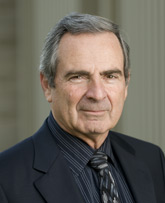

Friday - March 20, 2009
SLAC Today is
available online at:
http://today.slac.stanford.edu
In this issue:
From the Director of Operations: an IT Migration Project
SLAC Shines in Condensed Matter Physics at the March APS Meeting
TeV Particle Astrophysics Conference Registration Open
Word of the Week: Dark Matter
 |
 |
|
Friday - March 20, 2009 |
From the Director of Operations: an IT Migration Project Imagine a SLAC with electronic timecards, or that one click at your desktop could display your annual budget and expenses to date. With one more click, you could see who has been charging your account. If you are doing work at both Stanford's main campus and SLAC, one common information environment would support all of your business needs. Well, enjoy that image, because plans are underway to make this your reality. Here are some elements of the challenge. The heart of Human Resources and financial information is the institutional enterprise system. Here at SLAC, our current enterprise systems are outdated, sitting on unreliable hardware platforms with questionable longevity. Many business processes are not fully implemented on these central systems, but rather on systems owned by the individual directorates. Read more... SLAC Shines in Condensed Matter Physics at the March APS MeetingSLAC physicist Yves Acremann presents work on ultrafast spectroscopy on solids. (Photo courtesy of Nick Breznay. Click for larger image.)
SLAC is making a strong showing at the 2009 March Meeting of the American Physical Society this week in Pittsburgh, with 48 scientists and 81 papers representing the lab—a marked increase from past years. Historically, fewer SLAC scientists have contributed to the March Meeting, which has a heavy focus on condensed matter physics, compared to the more high-energy-physics-friendly April Meeting. But all this week, several dozen faculty, post-doctoral researchers and graduate students from the Stanford Institute for Material and Energy Science, or SIMES, a joint SLAC-Stanford collaboration, have presented work on a wide range of exciting issues in condensed matter physics. Their papers cover topics from graphene nano-ribbons to topological insulators to the newly discovered family of iron-based superconductors. The convention center's exhibition hall teems with posters and physicists at the APS March Meeting. (Photo courtesy of Nick Breznay. Click for larger image.)
"It's a pretty strong presence, and a lot of interesting results," said SIMES Director Zhi-Xun Shen, who is also attending the meeting. "It's fair to say that, through the SIMES institute, SLAC now has one of the strongest condensed matter physics programs in the world." SLAC physicists also presented new techniques from the Stanford Synchrotron Radiation Lightsource and the upcoming Linac Coherent Light Source that will help condensed-matter physicists glean information about exotic states of matter. And the meeting's talks and poster sessions are an excellent opportunity to mix with like-minded researchers from other institutions. "It's important to get to know the state-of-the-art of the field," said Yves Acremann, a physicist from the joint SLAC-Stanford PULSE Institute for Ultrafast Energy Science. "We learn what we could do to address problems in solid state physics with the methods which are unique to SLAC." TeV Particle Astrophysics Conference Registration OpenRegistration is now open for TeV Particle Astrophysics 2009 at SLAC. The focus of this July 13–17 conference is to understand what can be learned from both the LHC and a broad range of astrophysical experiments that address some of the most pressing questions in physics today, including the nature of dark matter and the origin of cosmic rays. The meeting will provide an occasion for theorists and experimentalists to discuss the latest and upcoming results in these fields and to consider new strategies, technologies and collaborative efforts. A block of rooms at a special rate has been reserved at the Stanford Guest House on the SLAC campus. Further details and conference registration are available on the conference Web site. Please direct any questions to Thanh Ly (x4496). Word of the Week: Dark MatterDark matter is one of the most prevalent and mysterious components of our universe. It is "dark" for two reasons: one, it doesn't interact with electromagnetic forces, meaning it's invisible to our eyes and our best telescopes alike; and two, we don't know what it is. Astronomers infer the existence of dark matter, which makes up about 20 percent of the energy density of the universe, from its gravitational effect on normal matter. For instance, galaxies spin faster than they should based on how many stars they have; the extra gravitational kick is attributed to dark matter. A team of SLAC astronomers recently used two space telescopes to observe dark matter's effects in two merging galaxy clusters. The dark matter sailed through normal matter without slowing down, leaving no hint of its presence except by warping the light from galaxies in the background. |
Events (see all | submit)
Access (see all)
Announcements
|
|
| | ||
|
|
||
 <%
Response.AddHeader "Last-modified", getArticleDate()
'Response.AddHeader "Last-modified","Mon, 01 Sep 1997 01:03:33 GMT"
'Monday, December 06, 2010
%>
<%
Response.AddHeader "Last-modified", getArticleDate()
'Response.AddHeader "Last-modified","Mon, 01 Sep 1997 01:03:33 GMT"
'Monday, December 06, 2010
%>View online at http://today.slac.stanford.edu/. |
||